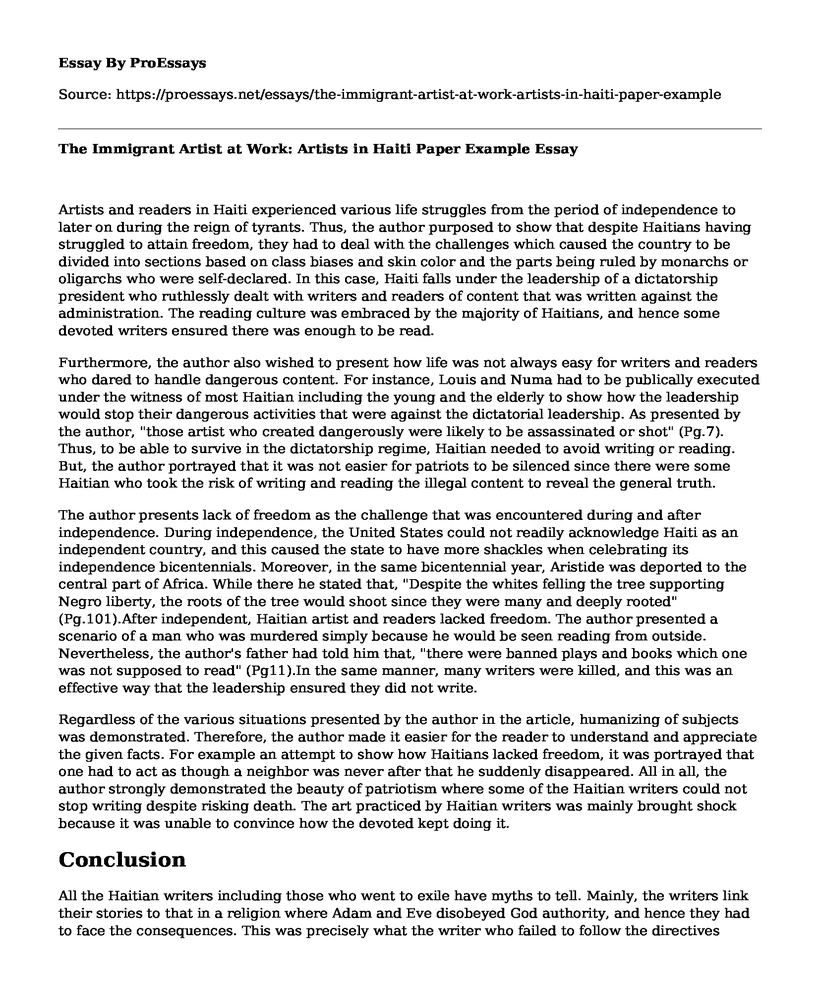Artists and readers in Haiti experienced various life struggles from the period of independence to later on during the reign of tyrants. Thus, the author purposed to show that despite Haitians having struggled to attain freedom, they had to deal with the challenges which caused the country to be divided into sections based on class biases and skin color and the parts being ruled by monarchs or oligarchs who were self-declared. In this case, Haiti falls under the leadership of a dictatorship president who ruthlessly dealt with writers and readers of content that was written against the administration. The reading culture was embraced by the majority of Haitians, and hence some devoted writers ensured there was enough to be read.
Furthermore, the author also wished to present how life was not always easy for writers and readers who dared to handle dangerous content. For instance, Louis and Numa had to be publically executed under the witness of most Haitian including the young and the elderly to show how the leadership would stop their dangerous activities that were against the dictatorial leadership. As presented by the author, "those artist who created dangerously were likely to be assassinated or shot" (Pg.7). Thus, to be able to survive in the dictatorship regime, Haitian needed to avoid writing or reading. But, the author portrayed that it was not easier for patriots to be silenced since there were some Haitian who took the risk of writing and reading the illegal content to reveal the general truth.
The author presents lack of freedom as the challenge that was encountered during and after independence. During independence, the United States could not readily acknowledge Haiti as an independent country, and this caused the state to have more shackles when celebrating its independence bicentennials. Moreover, in the same bicentennial year, Aristide was deported to the central part of Africa. While there he stated that, "Despite the whites felling the tree supporting Negro liberty, the roots of the tree would shoot since they were many and deeply rooted" (Pg.101).After independent, Haitian artist and readers lacked freedom. The author presented a scenario of a man who was murdered simply because he would be seen reading from outside. Nevertheless, the author's father had told him that, "there were banned plays and books which one was not supposed to read" (Pg11).In the same manner, many writers were killed, and this was an effective way that the leadership ensured they did not write.
Regardless of the various situations presented by the author in the article, humanizing of subjects was demonstrated. Therefore, the author made it easier for the reader to understand and appreciate the given facts. For example an attempt to show how Haitians lacked freedom, it was portrayed that one had to act as though a neighbor was never after that he suddenly disappeared. All in all, the author strongly demonstrated the beauty of patriotism where some of the Haitian writers could not stop writing despite risking death. The art practiced by Haitian writers was mainly brought shock because it was unable to convince how the devoted kept doing it.
Conclusion
All the Haitian writers including those who went to exile have myths to tell. Mainly, the writers link their stories to that in a religion where Adam and Eve disobeyed God authority, and hence they had to face the consequences. This was precisely what the writer who failed to follow the directives issued by the dictatorial leadership had to face. For instance, Louis and Numa were publically executed to serve as a warning to the general public concerning doing what was against the administration. Additionally, the author demonstrated that just like how Eve and Adam had to quit Eden, which was the same way any individual doing contrary to the leadership had to quit Haiti.
Works Cited
Danticat, Edwidge. Create dangerously: The immigrant artist at work. Vintage, 2011.
Cite this page
The Immigrant Artist at Work: Artists in Haiti Paper Example. (2022, Sep 26). Retrieved from https://proessays.net/essays/the-immigrant-artist-at-work-artists-in-haiti-paper-example
If you are the original author of this essay and no longer wish to have it published on the ProEssays website, please click below to request its removal:
- Importance of the Global Women's Leadership Scholarship Programme
- The Contribution of the Feminine Genius to the Church Essay
- Paper Example on Cesar Pelli, Architectural Designer
- The Nature and Evidence of Gender Pay Gap Essay Example
- Essay Sample on Social Media's Effect on Community Involvement
- Essay Sample on Racial Hoaxes in USA: Preconceived Beliefs and High-Profile Cases
- Postmodernism: A Movement to Challenge Modernism - Free Essay Sample







